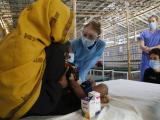Mar 8, 2002 (CIDRAP News) – Tularemia, one of the six diseases considered most likely to be spread by bioterrorists, remains uncommon in the United States, with 1,368 cases reported between 1990 and 2000, according to the Centers for Disease Control and Prevention (CDC).
The CDC is reporting on tularemia trends to provide health professionals with background information that could help them spot unusual patterns of cases, including bioterrorism events, states the article in today's issue of Morbidity and Mortality Weekly Report.
Tularemia was dropped from the list of nationally notifiable diseases in 1994 but restored in 2000 because of concern about possible bioterrorism. The disease is caused by the gram-negative coccobacillus Francisella tularensis, spread mainly by tick and deerfly bites and contact with infected animals, especially rabbits. The incidence of the disease peaked in 1939, declined substantially in the 1950s and 1960s, and has remained stable since then, the CDC reports.
The 1,368 cases reported in the 1990s included 807 (59%) confirmed cases, 85 (6%) probable cases, and 476 (35%) cases of unknown classification. Cases were reported in 44 states, but just four states accounted for 56% of cases: Arkansas, 23%; Missouri, 19%; South Dakota, 7%; and Oklahoma, 7%. About 17% of US counties reported at least one case.
By ethnicity, tularemia was most common among American Indians and Alaska natives (0.5 cases per 100,000, versus 0.04 per 100,000 among whites). By age, incidence was highest among children aged 5 to 9 years and people 75 or older.
In the past, most tularemia cases occurred in summer as a result of tick bites and in winter because of hunters' handling of infected rabbit carcasses, the CDC reports. But in recent years the only seasonal increase in cases has occurred in late spring and summer, the report says.
Tularemia typically presents as an acute febrile illness and can cause various clinical manifestations, including skin ulcers, pharyngitis, ocular lesions, regional lymphadenopathy, and pneumonia, the CDC says. Bioterrorism experts predict that attackers attempting to spread F tularensis would probably use an aerosolized form. "Outbreaks of pneumonic tularemia, particularly in low-incidence areas, should prompt consideration of bioterrorism," the CDC report states.
CDC. Tularemia—United States, 1990-2000. MMWR 2002;51(09):182-4
http://www.cdc.gov/mmwr/preview/mmwrhtml/mm5109a1.htm



















